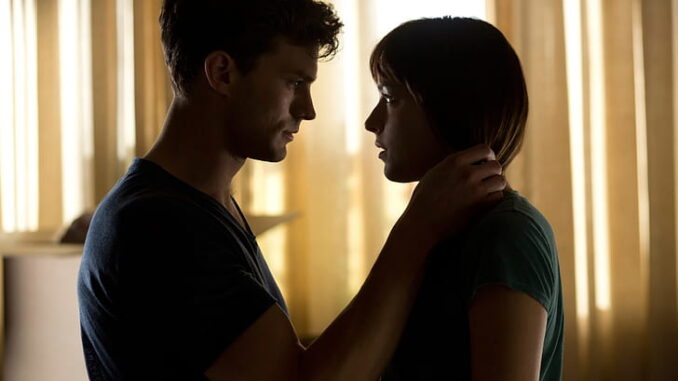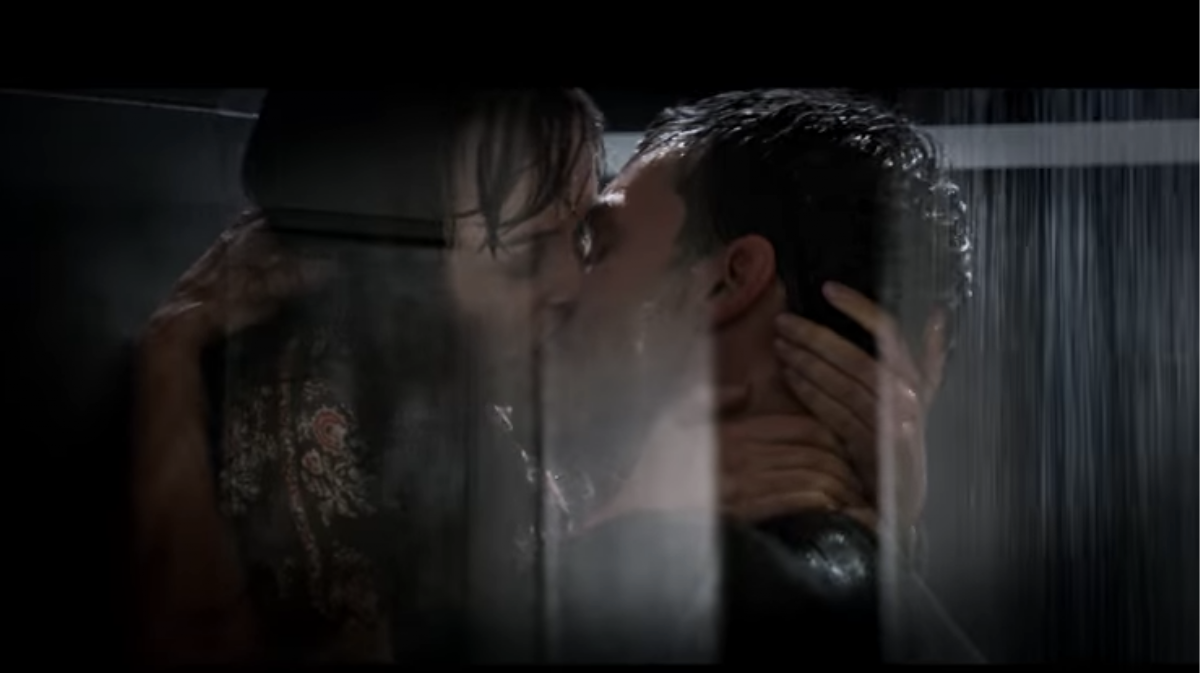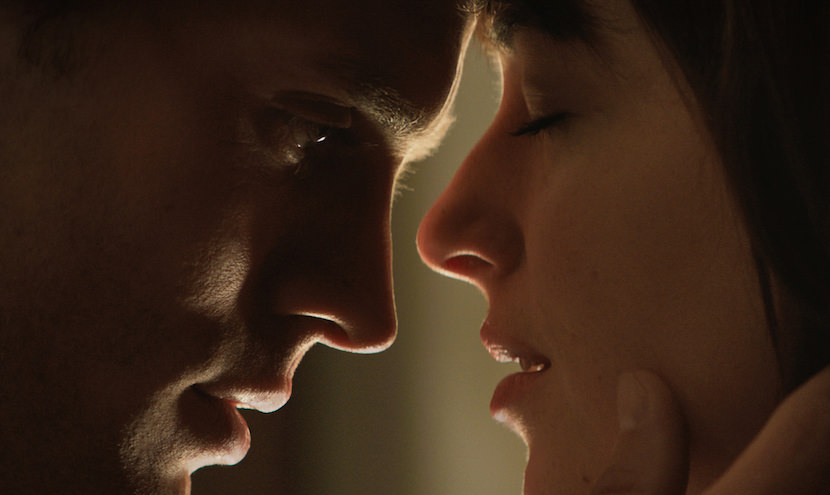
Review: In ‘Fifty Shades of Grey’ Movie, Sex Is a Knotty Business

At the end of a recent New York sneak preview of “Fifty Shades of Grey” — in the blackout between the final lines of dialogue (“Anastasia!” “Christian!”) and the first breathy notes of the last Beyoncé song — a lot of the audience burst out laughing. The source of that laughter continues to puzzle and intrigue me, perhaps more than the actual movie did. Was it delight? Derision? Embarrassment? Surprise? All of the above?
The last answer seems the most likely, since Sam Taylor-Johnson’s screen adaptation of E. L. James’s best seller is, like the book itself, a wildly confused treatment of a perennial confusing subject. Sex is a knotty business, perhaps all the more so when actual knots are involved, as they tend to be in the world of Christian Grey, the kinky billionaire bachelor who lends his name and his impressive collection of neckties to this Seattle-set tale of seduction, submission and commodity fetishism.
Christian has a lot of psychic baggage, but for most of this installment in the “Fifty Shades” trilogy, it’s obscured by his physical stuff. In the tradition of Leonardo DiCaprio’s Jay Gatsby, James Franco’s Alien (from “Spring Breakers”) and Kanye West’s Kanye West, this young mogul (played by Jamie Dornan) treats luxury consumption as an erotic passion and a spiritual calling. He has his own helicopter, which he pilots himself; an underground garage full of cars with a chauffeur to drive them; a penthouse apartment with a grand piano; and a walk-in closet so big that his suits hang without even touching.

There’s also another room where he keeps his collection of canes, cuffs and other specialized equipment. Early in their relationship, he gives a tour to Anastasia Steele, his young inamorata, played with captivating sensitivity by Dakota Johnson. “That’s a flogger,” he explains, in one of several moments in Kelly Marcel’s script that sound a little redundant, and more than a little silly, when uttered on screen.
Anastasia’s portion of the dialogue is more likely to be funny on purpose. Critics of Ms. James’s books have called attention to Ana’s habit of exclaiming “Wow!” and “Holy crap!” when a more heightened vocabulary (or no words at all) might seem to be called for. But the energy that brings her and Christian together is comic as well as sexual. She’s an ordinary, guileless, somewhat clueless young woman — kind of basic, as they say nowadays — pulled into the orbit of an enigmatic aristocrat with peculiar tastes and dark secrets. Their first meeting takes place in his office, where Anastasia, with her messy bangs and shapeless blue cardigan, looks absurdly out of place amid the sleek corporate Valkyries. “Fifty Shades” may have begun as “Twilight” fan fiction, but Ms. Taylor-Johnson wittily notes its kinship with “The Devil Wears Prada.”
Not that professional ambition plays much of a role in Anastasia’s life. Or, for that matter, in Christian’s. He runs a big, vague company but doesn’t really seem to do much work. Ana is an English major who works part time in a hardware store, which is one of the places Christian shows up to surprise her. He’s always doing that — at a nightclub, at her apartment, at a hotel bar in Savannah, Ga., where she’s having a drink with her mom. It’s a little unnerving.
Mr. Dornan, given the job of inspiring lust, fascination and also maybe a tiny, thrilling frisson of fear, succeeds mainly in eliciting pity. In print, Christian is a blur and a blank — a screen onto which any given reader can project a customized masculine ideal. On the screen, he risks becoming just some guy, which is how Mr. Dornan plays him, without mischief or mystery. There are actors who might have given Christian a jolt of naughty, bossy life, most of them creatures of an earlier movie era. Cary Grant. William Powell. Paul Newman. Sean Connery if you wanted the roughness a little closer to the surface. Jamie Bell was a convincing dominant in Lars von Trier’s “Nymphomaniac: Volume II,” though his character was more artisan than aristocrat.

Mr. Dornan has the bland affect of a model, by which I mean a figure made of balsa wood or Lego. What vitality “Fifty Shades of Grey” possesses belongs to Ms. Johnson, who is a champion lip-biter and no slouch at blushing, eye-rolling and trembling on the verge of tears. She’s a good actress, in other words, and Ms. Taylor-Johnson matches the colors and the visual texture — the chilly blues and pulsing reds, the drab daylight and the velvety dusk — to Anastasia’s moods and desires.
These are kind of a mess. The problem isn’t that she’s indecisive or conflicted or capricious, or that she reacts to Christian’s proposal of a formal, contractually established dominant-submissive relationship with ambivalence. Who wouldn’t? (And I’m not passing judgment on his lifestyle. It’s just that I have a strong bias against having sex with anyone who would use the word “incentivize” in conversation, as Christian does the very first time he and Anastasia lock eyes.) The problem is that as a character, Anastasia makes no sense. Her behavior has no logic, no pattern, no coherent set of causes or boundaries.
In the book, this hardly matters. In fact, it’s something of an asset. Anastasia’s inner life exists to fill the space between sex scenes, and her zigzagging responses to Christian’s proposals make the fantasy more inclusive while also providing an escape clause. “Fifty Shades” is both daring and conventional, falling back into traditional gender roles even as it plays with transgressive desires. Christian’s sexual tastes are intriguing to Anastasia, but they are also the result of emotional wounds that she sets herself the task of healing. He wants to take charge of her, and she wants to take care of him. She tolerates the kind of sex he wants, and even enjoys some of it, but what she really wants is something more, and she wants to make him want that, too. She loves him, but love in these tales functions less as an emotional ideal than as a literary safe word, a return ticket to the land of romance.

Reviewers have complained about Ms. James’s pedestrian prose, but the bad writing serves an important purpose. “Fifty Shades” not only destigmatizes kink, bringing bondage and spanking to airport bookstores and reading groups across the land. But it also, so to speak, de-sophisticates certain sexual practices, taking them out of the chateau and the boudoir and other fancy French places and planting them in the soil of Anglo-American banality. If E. L. James were a better writer, her books would be more — to use one of Anastasia’s favorite words — intimidating. And much less useful.
The movie is neither one of those things. It dabbles in romantic comedy and splashes around in melodrama, but the one thing it can’t be — the thing the novel so trashily and triumphantly is — is pornography. Ms. Taylor-Johnson’s sex scenes are not that much different from other R-rated sex scenes, though there are more of them and more hardware is involved. You know the routine: an arched neck, some curled toes, a buttock here, a breast there, a wisp of pubic hair, a muffled moan, another Beyoncé song. Maybe a riding crop for variety.
W.H. Auden once wrote that “the proof that pornography has no literary value is that, if one attempts to read it in any other way than as a sexual stimulus, to read it, say, as a psychological case-history of the author’s sexual fantasies, one is bored to tears.” In defiance of this irrefutable good sense, the “Fifty Shades” phenomenon has spawned innumerable kink-themed think pieces, though the analysis has dwelt less on Ms. James’s psyche than on the fantasies of the tens of millions of women who have bought her books. The writers transform their boredom into mockery and judgment as they circle around a tantalizing, perhaps frustrating question. Why do so many women read these novels, even though they have no literary value?
I’m no expert, but I can venture a guess: for fun. They seem to be the kind of books you can simultaneously have fun with, make fun of, trash and cherish and adapt to the pursuit of your own pleasures. Which brings me back to the laughter at the end of the sneak preview. “Fifty Shades of Grey” might not be a good movie — O.K., it’s a terrible movie — but it might nonetheless be a movie that feels good to see, whether you squirm or giggle or roll your eyes or just sit still and take your punishment.
“Fifty Shades of Grey” is rated R (Under 17 requires accompanying parent or adult guardian). Different strokes.
